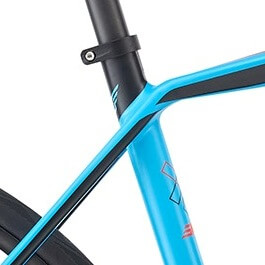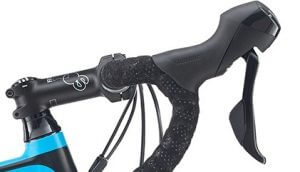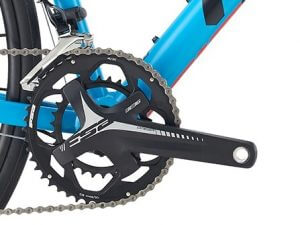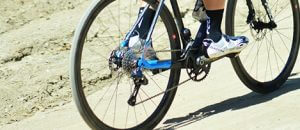Felt VR30 Review – Strong Value in a Versatile Gravel Capable Road Bike
For 2017, Felt has replaced both the V series adventure bikes and the Z series of endurance road geometry bikes with a single VR series of bikes. The Felt VR bikes cover a broad spectrum of price points and today’s review bike – the Felt VR30 – finds itself near the top of the aluminum frame equipped bikes and is priced at $1700. Based upon what we saw with the Felt V55 and V85 last year, the Felt VR30 is in a popular price range. The Shimano 105 based drivetrain puts The VR30 into a high value spec as it is the first level of Shimano’s true enthusiast level parts – components that are designed for serviceability and to hold up well for people who ride their bike with regularity. With no further ado, here is what we like and would change on the Felt VR30.
 Felt VR30 Frame and Fork Details
Felt VR30 Frame and Fork Details
The Felt VR30 is constructed of butted, hydroformed aluminum tubing, with a carbon fiber fork. The bottom bracket is of the BB386 design and is something new for Felt on this type of bike as both the Z and V lines that the VR line replaces used traditional threaded bottom brackets. The BB386 is a PressFit-type of design that provides for a wider, and thus stiffer, bottom bracket area of the frame. As a mechanic I wish they had stuck with the threaded BB design as threaded bottom brackets tend to be the quietest and easiest to service, but the BB386 design allows the frame to accommodate tires wider than 28mm easier and it saves some weight.
The rear triangle on the Felt VR30 is spaced at 12 x 142 mm with a Syntace style thru axle dropout. This is a nice update from the 2016 V85 and V55, both of which used quick release dropouts. The front and rear brake mounts are designed for the evolving flat-mount standard brake calipers. While we don’t see the flat-mount being a big deal one way or the other on a bike like the VR 30, it is a nice touch and guarantees that the frame will work with as many future brake systems/components as possible. All shifter cables are routed internally on the Felt VR30, as is the hydraulic brake hose to the rear brake. The carbon fork is tapered, with a 1.125″ bearing at the top and a 1.5″ bearing at the bottom to maximize lateral stiffness. Again, this is another feature that is becoming more of a standard on adventure bikes and increasingly common on road bikes as well. As a result, according to Felt, the front end of the VR bike is stiffer (23% to be exact) than the closest equivalent Z series bikes from the previous year. This not only improves handling and control on rougher surfaces, such as dirt and gravel roads, but also on paved roads.
30, it is a nice touch and guarantees that the frame will work with as many future brake systems/components as possible. All shifter cables are routed internally on the Felt VR30, as is the hydraulic brake hose to the rear brake. The carbon fork is tapered, with a 1.125″ bearing at the top and a 1.5″ bearing at the bottom to maximize lateral stiffness. Again, this is another feature that is becoming more of a standard on adventure bikes and increasingly common on road bikes as well. As a result, according to Felt, the front end of the VR bike is stiffer (23% to be exact) than the closest equivalent Z series bikes from the previous year. This not only improves handling and control on rougher surfaces, such as dirt and gravel roads, but also on paved roads.
The seatstays on the aluminum frames in the VR line now surround the outside of the seat tube instead of just attaching to the back as most Felt alloy bikes have done in the past. The result is that the seat tube is not as firmly buttressed from the rear, allowing more movement of the seat tube front to back, for additional comfort. According to Felt, this increases the movement of the saddle 74%. This motion is nothing that you will feel per se, except that the bike will feel more complaint and smoother, particularly over rough surfaces, because of it.
Felt VR30 Shimano Drivetrain and Brakes
 With the exception of the crankset, the entire drivetrain and brake system on the Felt VR30 is from Shimano. The shifters are Shimano RS505, the first level of Shimano STI that offers hydraulic brakes and mechanical shifting. The front and rear derailleurs are Shimano 105 and the high wear parts (chain and cassette) are also Shimano, but non-series parts to provide the gearing Felt wanted and hit the price range. The cassette has an 11-32 gearing spread, something we have come to expect on adventure bikes. The flat mount hydraulic brake calipers are Shimano RS505, with a 140 mm Shimano Ice-Tech rotor in the rear and a 160 mm Ice-Tech rotor in the front. Braking on the Felt VR30, once the pads have been bedded in of course, is very strong with minimal lever effort and very good modulation. Although the Shimano RS505 brake/shift levers look a bit clunky compared to the pricier RS685 levers, braking performance felt very similar to the benchmark RS685.
With the exception of the crankset, the entire drivetrain and brake system on the Felt VR30 is from Shimano. The shifters are Shimano RS505, the first level of Shimano STI that offers hydraulic brakes and mechanical shifting. The front and rear derailleurs are Shimano 105 and the high wear parts (chain and cassette) are also Shimano, but non-series parts to provide the gearing Felt wanted and hit the price range. The cassette has an 11-32 gearing spread, something we have come to expect on adventure bikes. The flat mount hydraulic brake calipers are Shimano RS505, with a 140 mm Shimano Ice-Tech rotor in the rear and a 160 mm Ice-Tech rotor in the front. Braking on the Felt VR30, once the pads have been bedded in of course, is very strong with minimal lever effort and very good modulation. Although the Shimano RS505 brake/shift levers look a bit clunky compared to the pricier RS685 levers, braking performance felt very similar to the benchmark RS685.
Felt VR30 Low Gearing
While we are normally a bit critical when a company uses a crankset that is not the same brand as the derailleurs – in this case Shimano – the FSA Omega crankset is worthy of positive mention in this case because of the 46/30 gearing combination. We keep getting requests for lower gearing, not only for our Vermont clients, but from riders all over the country. If you are on the dirt and gravel roads here in Ver mont, you will run into steeper hills than you find on most paved roads, and that lower gearing can be very helpful. Most road bikes, and adventure bikes, come with a compact road crankset (i.e. 50/34 gearing), which works well for folks ready to push wide ratio road gearing. However, Felt has apparently been listening to many people who have been saying that wide ratio road gearing is not as low as they want and they spec’d an adventure bike crank and overall gearing that has a lowest gear combination of 30 front/32 rear, less than a 1:1 ratio. Yes, I can come up with ways for you to get lower gearing than that (I just finished building a road bike with an 11-42 cassette!), but you will find few road bikes (regardless of price) that offer such dirt road friendly gearing as the Felt VR30 out of the box. Drawbacks to this gearing? For the majority of road riders, a 46 tooth large chainring will work fine. However, faster riders may find that they “spin out” when really pushing (likely on paved descents). We like the gearing of the Felt VR30 – it suits the target rider well.
mont, you will run into steeper hills than you find on most paved roads, and that lower gearing can be very helpful. Most road bikes, and adventure bikes, come with a compact road crankset (i.e. 50/34 gearing), which works well for folks ready to push wide ratio road gearing. However, Felt has apparently been listening to many people who have been saying that wide ratio road gearing is not as low as they want and they spec’d an adventure bike crank and overall gearing that has a lowest gear combination of 30 front/32 rear, less than a 1:1 ratio. Yes, I can come up with ways for you to get lower gearing than that (I just finished building a road bike with an 11-42 cassette!), but you will find few road bikes (regardless of price) that offer such dirt road friendly gearing as the Felt VR30 out of the box. Drawbacks to this gearing? For the majority of road riders, a 46 tooth large chainring will work fine. However, faster riders may find that they “spin out” when really pushing (likely on paved descents). We like the gearing of the Felt VR30 – it suits the target rider well.
Felt VR30 Wheels and Contact Points
The remainder of the components on the VR30 are by Felt. The seatpost is carbon fiber, to dampen shock and vibration while looking cool. The stem and handlebars are Felt labeled aluminum units with well thought out short reach and drop (65mm/125mm) handlebars. The wheels are by Felt, featuring 28 spokes front and rear, with a 19mm internal width tubeless ready bead rims. The hubs are Felt alloy with centerlock brake rotor mounts for use with the broadest range of rotors from Shimano. Like all bikes in this price range, the wheels are not fancy and are the first item to upgrade if you want to enhance performance and take off significant weight. However, the stock Felt VR30 wheels are well built and should prove reliable. Tires are 700×28 Vittoria Zaffiro and the saddle is a name brand Kappa Space from Pro Logo. Depending on size, the Felt VR30 weighs between 21 and 21.75 lbs. While the weight is not light from a narrow tire road bike perspective, it is competitive for a disc brake equipped road bike at its price point.
Felt VR30 Fit and Frame Geometry
The Felt VR30 is available in a pretty standard and wide array of sizes: 47, 51, 54, 56, 58, 61 cm. As mentioned in our original post on the VR series of bikes, the frame geometry of the VR bikes splits the previous Z series of endurance road bikes and the V series of adventure bikes. This is not surprising as Felt has positioned the VR in their offerings to replace both of those series for 2017. While we feel like the VR bikes will do an excellent job of replacing the Felt Z line – adding versatility and improving general fit characteristics across the board – people closer to the edge of the sizing curb who found a good home on the V adventure bikes in the past may no longer have a home on a Felt as the VR has less stack and more reach in most sizes. The only way to know for sure what bikes will work best for you is to start your bike search with a fitting first and then use that information to find out what frames will support your riding position best. Doing it any other way, means you will have to adapt to the bike’s needs and that is never a good strategy. To find out if a Felt VR30 fits you well, contact us for a Rider First Bike Fitting before you buy.
Felt VR30 Ride Quality
 Felt did a nice job with the frame on the VR30. It is a nice combination of smooth and responsive with excellent stability. The front of the VR30 is stouter feeling than the V55 and V85 of last year though and that is simply because the VR30 is not a dedicated adventure road bike that can ride on 40mm tires if wanted – it is more of a gravel capable endurance road bike. Expect a little more chatter from rough surfaces than you would on frame designed for wider tires. As far as building a bike that will do almost anything that a dedicated narrow tire road bike will do while offering you the ability to attack all but the roughest and loosest of gravel roads, the Felt VR30 is a winner.
Felt did a nice job with the frame on the VR30. It is a nice combination of smooth and responsive with excellent stability. The front of the VR30 is stouter feeling than the V55 and V85 of last year though and that is simply because the VR30 is not a dedicated adventure road bike that can ride on 40mm tires if wanted – it is more of a gravel capable endurance road bike. Expect a little more chatter from rough surfaces than you would on frame designed for wider tires. As far as building a bike that will do almost anything that a dedicated narrow tire road bike will do while offering you the ability to attack all but the roughest and loosest of gravel roads, the Felt VR30 is a winner.
Contact us for more information on the Felt VR30 and to discuss how you can get a bike matched to your needs and ready to explore roads new and old.

